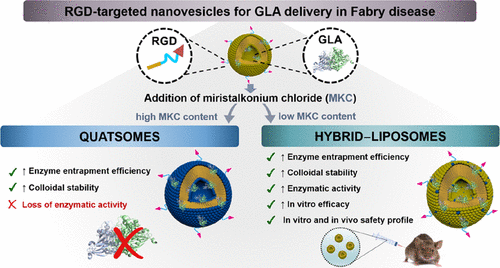News

Impact of Chemical Composition on the Nanostructure and Biological Activity of α Galactosidase Loaded Nanovesicles for Fabry Disease Treatment
Fabry disease is a rare lysosomal storage disorder characterized by a deficiency of α-galactosidase A (GLA), a lysosomal hydrolase. The enzyme replacement therapy administering naked GLA shows several drawbacks including poor biodistribution, limited efficacy, and relatively high immunogenicity in Fabry patients. An attractive strategy to overcome these problems is the use of nanocarriers for encapsulating the enzyme. Nanoliposomes functionalized with RGD peptide have already emerged as a good platform to protect and deliver GLA to endothelial cells. However, low colloidal stability and limited enzyme entrapment efficiency could hinder the further pharmaceutical development and the clinical translation of these nanoformulations. Herein, the incorporation of the cationic miristalkonium chloride (MKC) surfactant to RGD nanovesicles is explored, comparing two different nanosystems-quatsomes and hybrid liposomes. In both systems, the positive surface charge introduced by MKC promotes electrostatic interactions between the enzyme and the nanovesicles, improving the loading capacity and colloidal stability. The presence of high MKC content in quatsomes practically abolishes GLA enzymatic activity, while low concentrations of the surfactant in hybrid liposomes stabilize the enzyme without compromising its activity. Moreover, hybrid liposomes show improved efficacy in cell cultures and a good in vitro/in vivo safety profile, ensuring their future preclinical and clinical development.
More information can be found here
